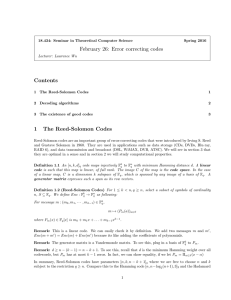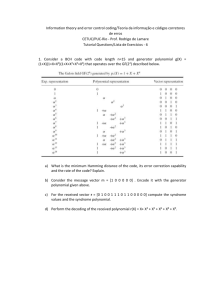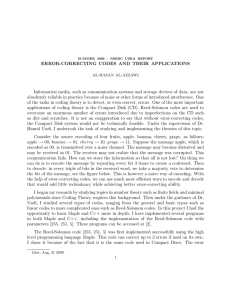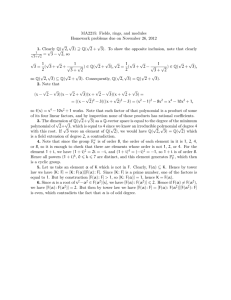Mathematics 366 Reed Solomon Codes A. Hulpke
advertisement
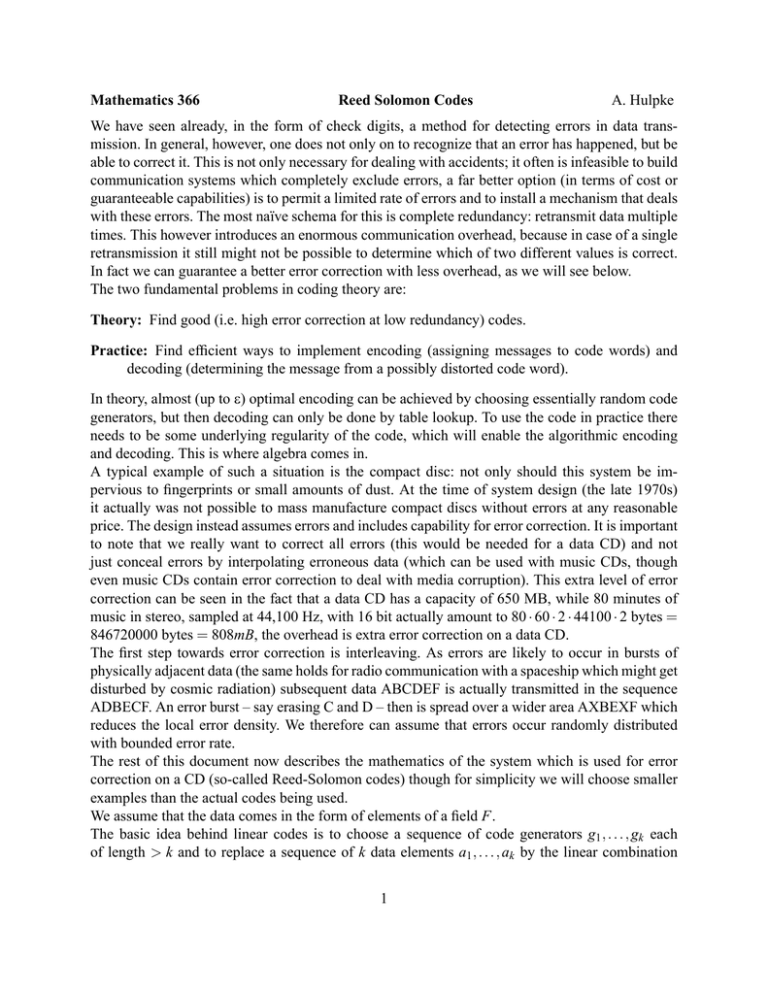
Mathematics 366
Reed Solomon Codes
A. Hulpke
We have seen already, in the form of check digits, a method for detecting errors in data transmission. In general, however, one does not only on to recognize that an error has happened, but be
able to correct it. This is not only necessary for dealing with accidents; it often is infeasible to build
communication systems which completely exclude errors, a far better option (in terms of cost or
guaranteeable capabilities) is to permit a limited rate of errors and to install a mechanism that deals
with these errors. The most naı̈ve schema for this is complete redundancy: retransmit data multiple
times. This however introduces an enormous communication overhead, because in case of a single
retransmission it still might not be possible to determine which of two different values is correct.
In fact we can guarantee a better error correction with less overhead, as we will see below.
The two fundamental problems in coding theory are:
Theory: Find good (i.e. high error correction at low redundancy) codes.
Practice: Find efficient ways to implement encoding (assigning messages to code words) and
decoding (determining the message from a possibly distorted code word).
In theory, almost (up to ε) optimal encoding can be achieved by choosing essentially random code
generators, but then decoding can only be done by table lookup. To use the code in practice there
needs to be some underlying regularity of the code, which will enable the algorithmic encoding
and decoding. This is where algebra comes in.
A typical example of such a situation is the compact disc: not only should this system be impervious to fingerprints or small amounts of dust. At the time of system design (the late 1970s)
it actually was not possible to mass manufacture compact discs without errors at any reasonable
price. The design instead assumes errors and includes capability for error correction. It is important
to note that we really want to correct all errors (this would be needed for a data CD) and not
just conceal errors by interpolating erroneous data (which can be used with music CDs, though
even music CDs contain error correction to deal with media corruption). This extra level of error
correction can be seen in the fact that a data CD has a capacity of 650 MB, while 80 minutes of
music in stereo, sampled at 44,100 Hz, with 16 bit actually amount to 80 · 60 · 2 · 44100 · 2 bytes =
846720000 bytes = 808mB, the overhead is extra error correction on a data CD.
The first step towards error correction is interleaving. As errors are likely to occur in bursts of
physically adjacent data (the same holds for radio communication with a spaceship which might get
disturbed by cosmic radiation) subsequent data ABCDEF is actually transmitted in the sequence
ADBECF. An error burst – say erasing C and D – then is spread over a wider area AXBEXF which
reduces the local error density. We therefore can assume that errors occur randomly distributed
with bounded error rate.
The rest of this document now describes the mathematics of the system which is used for error
correction on a CD (so-called Reed-Solomon codes) though for simplicity we will choose smaller
examples than the actual codes being used.
We assume that the data comes in the form of elements of a field F.
The basic idea behind linear codes is to choose a sequence of code generators g1 , . . . , gk each
of length > k and to replace a sequence of k data elements a1 , . . . , ak by the linear combination
1
a1 g1 + a2 g2 + · · · + ak gk , which is a slightly longer sequence. This longer sequence (the code word)
is transmitted. We define the code to be the set of all possible code words.
For example
(assuming the field
with 2 elements) if the gi are given by the rows of the generator
1 0 0 1 0 0
matrix 0 1 0 0 1 0 we would replace the sequence a, b, c by a, b, c, a, b, c, while (a
0 0 1 0 0 1
1 0 1 0 1 0 1
code with far better error correction!) the matrix 0 1 1 0 0 1 1 would have us replace
0 0 0 1 1 1 1
a, b, c by
a, b, a + b, c, a + c, b + c, a + b + c.
We notice in this example that there are 23 = 8 combinations, any two of which differ in at least
3 places. If we receive a sequence of 7 symbols with at most one error therein, we can therefore
determine in which place the error occurred and thus can correct it. We thus have an 1-error
correcting code.
Next we want to assume (regularity!) that any cyclic shift of a code word is again a code word.
We call such codes cyclic codes. It now is convenient to represent a code word c0 , . . . , cn−1 by the
polynomial c0 +c1 x+c2 x2 +· · ·+cn−1 xn−11 . A cyclic shift now means to multiply by x, identifying
xn with x0 = 1. The transmitted messages therefore are not really elements of the polynomial ring
F[x], but elements of the factor ring F[x]/I with I = hxn − 1i C F[x]. The linear process of adding
up generators guarantees that the sum or difference of code words is again a code word. A cyclic
shift of a code word I + w then corresponds to the product (I + w) · (I + x). As any element of
F[x]/I is of the form I + p(x), demanding that cyclic shifts of code words are again code words
thus implies that the product of any code word (I + w) with any factor element (I + r) is again a
code word. We thus see that the code (i.e. the set of possible messages) is an ideal in F[x]/I. We
have seen in homework problem 47 that any such ideal — and thus any cyclic code – must arise
from an ideal I ≤ A C F[x], by problem 45 we know that A = hdi with d a divisor of xn − 1.
Together this shows that the code must be of the form hI + di with d | (xn − 1). If d = d0 + d1 x +
· · · + ds xs , we get in the above notation the generator matrix
d0 d1 · · · ds 0 0 · · · 0
0 d0 d1 · · · ds 0 · · · 0
0 0 d0 d1 · · · ds · · · 0
.
..
.
0 0 · · · 0 d0 d1 · · · ds
As d is a divisor of xn − 1 any further cyclic shift of the last generator can be expressed in terms of
the other generators. One can imagine the encoding process as evaluation of a polynomial at more
points than required for interpolation. This makes it intuitively clear that it is possible to recover
the correct result if few errors occur. The more points we evaluate at, the better error correction we
get (but also the longer the encoded message gets).
1 Careful:
We might represent elements of F also by polynomials. Do not confuse these polynomials with the code
polynomials
2
The task of constructing cyclic codes therefore has been reduced to the task of finding suitable (i.e.
guaranteeing good error correction and efficient encoding and decoding) polynomials d.
The most important class of cyclic codes are BCH-codes2 , which are defined by prescribing
the zeroes of d. One can show that a particular regularity of these zeroes produces good error
correction. Reed-Solomon Codes (as used for example on a CD) are an important subclass of these
codes.
To define such a code we start by picking a field with q elements. Such fields exists for any prime
power q = pm and can be constructed as quotient ring Z p [x]/ hp(x)i for p an irreducible polynomial
of degree m. (Using fields larger than Z p is crucial for the mechanism.) The code words of the code
will have length q − 1. If we have digital data it often is easiest to simply bundle by bytes and to
use a field with q = 28 = 256 elements.
We also choose the number s < q−1
2 of errors per transmission unit of q − 1 symbols which we want
to be able to correct. This is a trade-off between transmission overhead and correction capabilities,
a typical value is s = 2.
It is known that in any finite field there is a particular element α (a primitive root), such that
αq−1 = 1 but αk 6= 1 for any k < q − 1. (This implies that all powers αk (k < q − 1) are different.
Therefore every nonzero element in the field can be written as a power of α.) As every power
β = αk also fulfills that βq−1 = 1 we can conclude that
q−1
xq−1 − 1 = ∏ (x − αk ).
k=0
The polynomial d(x) = (x − α)(x − α2 )(x − α3 ) · · · (x − α2s ) therefore is a divisor of xq−1 − 1 and
therefore generates a cyclic code. This is the polynomial we use. The dimension (i.e. the minimal
number of generators) of the code then is q − 1 − 2s, respectively 2s symbols are added to every
q − 1 − 2s data symbols for error correction.
For example, take q = 8. We take the field with 8 elements as defined in GAP via the polynomial
x3 + x + 1, the element α is represented by Z(8). We also choose s = 1. The polynomial defining
the code is therefore d = (x − α)(x − α2 ).
gap> x:=X(GF(8),"x");;
gap> alpha:=Z(8);
Z(2^3)
gap> d:=(x-alpha)*(x-alpha^2);
x^2+Z(2^3)^4*x+Z(2^3)^3
We build the generator matrix from the coefficients of the polynomial:
gap> coe:=CoefficientsOfUnivariatePolynomial(d);
[ Z(2^3)^3, Z(2^3)^4, Z(2)^0 ]
gap> g:=NullMat(5,7,GF(8));;
2 R.C.
B OSE (1901-1987), since 1970 on professor for statistics here at CSU; D.K. R AY-C HAUDHURI, professor
at Ohio State (now retired); A. H OCQUENGHEM
3
gap> for i in [1..5] do g[i]{[i..i+2]}:=coe;od;Display(g);
z^3 z^4
1
.
.
.
.
. z^3 z^4
1
.
.
.
z = Z(8)
.
. z^3 z^4
1
.
.
.
.
. z^3 z^4
1
.
.
.
.
. z^3 z^4
1
To simplify the following description we convert this matrix into RREF. (This is just a base change
on the data and does not affect any properties of the code.)
gap> TriangulizeMat(g); Display(g);
1
.
.
.
. z^3 z^4
.
1
.
.
.
1
1
.
.
1
.
. z^3 z^5
.
.
.
1
. z^1 z^5
.
.
.
.
1 z^1 z^4
z = Z(8)
What does this mean now: Instead of transmitting the data ABCDE we transmit ABCDEPQ with
the two error correction symbols defined by
P = α3 A + B + α3C + αD + αE
Q = α4 A + B + α5C + α5 D + α4 E
For decoding and error correction we want to find (a basis of) the relations that hold for all the
rows of this matrix. This is the nullspace3 of the matrix (and in fact is the same as if we had not
RREF).
gap> h:=NullspaceMat(TransposedMat(g));;Display(h);
z^3
1 z^3 z^1 z^1
1
.
z = Z(8)
z^4
1 z^5 z^5 z^4
.
1
When receiving a message ABCDEPQ we therefore calculate two syndromes4
S = α3 A + B + α3C + αD + αE + P
T = α4 A + B + α5C + α5 D + α4 E + Q
If no error occurred both syndromes will be zero. However now suppose an error occurred and
instead of ABCDEPQ we receive A’B’C’D’E’P’Q’ where A0 = A + EA and so on. Then we get the
syndromes
S0 = α3 A0 + B0 + α3C0 + αD0 + αE 0 + P0
= α3 (A + EA ) + (B + EB ) + α3 (C + EC ) + α(D + ED ) + α(E + EE ) + (P + EP )
3
3
3
3
= α
| A + B + α C{z+ αD + αE + P} +α EA + EB + α EC + αED + αEE + EP
= 0 by definition of the syndrome
= α3 EA + EB + α3 EC + αED + αEE + EP
3 actually
the right nullspace, which is the reason why we need to transpose in GAP, which by default takes left
nullspaces
4 These syndromes are not unique. Another choice of nullspace generators would have yielded other syndromes.
4
and similarly
T 0 = α4 EA + EB + α5 EC + α5 ED + α4 EE + EQ
If symbol A’ is erroneous, we have that T 0 = αS0 , the error is EA = α4 S0 (using that α3 · α4 = 1).
If symbol B’ is erroneous, we have that T 0 = S0 , the error is EB = S0 .
If symbol C’ is erroneous, we have that T 0 = α2 S0 , the error is EC = α4 S0 .
If symbol D’ is erroneous, we have that T 0 = α4 S0 , the error is ED = α6 S0 .
If symbol E’ is erroneous, we have that T 0 = α3 S0 , the error is EE = α6 S0 .
If symbol P’ is erroneous, we have that S0 6= 0 but T 0 = 0, the error is EP = S0 .
If symbol Q’ is erroneous, we have that T 0 6= 0 but S0 = 0, the error is EQ = T 0 .
For an example, suppose we want to transmit the message
A = α3 ,
B = α2 ,
C = α,
D = α4 ,
E = α5 .
We calculate
P = α3 A + B + α3C + αD + αE = α6
Q = α4 A + B + α5C + α5 D + α4 E = 0
gap> a^3*a^3+a^2+a^3*a+a*a^4+a*a^5;
Z(2^3)^6
gap> a^4*a^3+a^2+a^5*a+a^5*a^4+a^4*a^5;
0*Z(2)
We can verify the syndromes for this message:
gap> S:=a^3*a^3+a^2+a^3*a+a*a^4+a*a^5+a^6;
0*Z(2)
gap> T:=a^4*a^3+a^2+a^5*a+a^5*a^4+a^4*a^5+0;
0*Z(2)
Now suppose we receive the message
A = α3 ,
B = α2 ,
C = α,
D = α3 ,
E = α5 ,
P = α6 ,
Q = 0.
We calculate the syndromes as S = 1, T = a4 :
gap> S:=a^3*a^3+a^2+a^3*a+a*a^3+a*a^5+a^6;
Z(2)^0
gap> T:=a^4*a^3+a^2+a^5*a+a^5*a^3+a^4*a^5+0;
Z(2^3)^4
We recognize that T = α4 S, so we see that symbol D is erroneous. The error is ED = α6 S = α6 and
thus the correct value for D is α3 − α6 = α4 .
5
gap> a^3-a^6;
Z(2^3)^4
It is not hard to see that if more (but not too many) than s errors occur, the syndromes still indicate
that an error happened, even though we cannot correct it any longer. (One can in fact determine the
maximum number of errors the code is guaranteed to detect, even if it cannot correct it any longer.)
This is used in the CD system by combining two smaller Reed-Solomon codes in an interleaved
way. The result is called a Cross-Interleave Reed-Solomon code (CIRC): Consider the message be
placed in a grid like this:
A B C D
E F G H
I J K L
The first code acts on rows (i.e. ABCD, EFGH,. . . ) and corrects errors it can correct. If it detects
errors, but cannot correct them, it marks the whole row as erroneous, for example:
A B C D
X X X X
I J K L
The second code now works on columns (i.e. AXI, BXJ) and corrects the values in the rows marked
as erroneous. (As we know which rows these are, we can still correct better than with the second
code alone!) One can show that this combination produces better performance than a single code
with higher error correction value s.
The Ubiquitous Reed-Solomon Codes
by Barry A. Cipra, Reprinted from SIAM News, Volume 26-1, January 1993
In this so-called Age of Information, no one need be reminded of the importance not only of speed
but also of accuracy in the storage, retrieval, and transmission of data. It’s more than a question
of “Garbage In, Garbage Out.” Machines do make errors, and their non-man-made mistakes can
turn otherwise flawless programming into worthless, even dangerous, trash. Just as architects
design buildings that will remain standing even through an earthquake, their computer counterparts
have come up with sophisticated techniques capable of counteracting the digital manifestations of
Murphy’s Law.
What many might be unaware of, though, is the significance, in all this modern technology, of
a five-page paper that appeared in 1960 in the Journal of the Society for Industrial and Applied
Mathematics. The paper, “Polynomial Codes over Certain Finite Fields,” by Irving S. Reed and
Gustave Solomon, then staff members at MIT’s Lincoln Laboratory, introduced ideas that form the
core of current error-correcting techniques for everything from computer hard disk drives to CD
players. Reed-Solomon codes (plus a lot of engineering wizardry, of course) made possible the
stunning pictures of the outer planets sent back by Voyager II. They make it possible to scratch
a compact disc and still enjoy the music. And in the not-too-distant future, they will enable the
profitmongers of cable television to squeeze more than 500 channels into their systems, making a
vast wasteland vaster yet.
6
“When you talk about CD players and digital audio tape and now digital television, and various
other digital imaging systems that are coming–all of those need Reed-Solomon [codes] as an
integral part of the system,” says Robert McEliece, a coding theorist in the electrical engineering
department at Caltech.
Why? Because digital information, virtually by definition, consists of strings of “bits”–0s and 1s–
and a physical device, no matter how capably manufactured, may occasionally confuse the two.
Voyager II, for example, was transmitting data at incredibly low power–barely a whisper–over
tens of millions of miles. Disk drives pack data so densely that a read/write head can (almost) be
excused if it can’t tell where one bit stops and the next one (or zero) begins. Careful engineering
can reduce the error rate to what may sound like a negligible level–the industry standard for hard
disk drives is 1 in 10 billion–but given the volume of information processing done these days,
that “negligible” level is an invitation to daily disaster. Error-correcting codes are a kind of safety
net–mathematical insurance against the vagaries of an imperfect material world.
The key to error correction is redundancy. Indeed, the simplest error-correcting code is simply to
repeat everything several times. If, for example, you anticipate no more than one error to occur
in transmission, then repeating each bit three times and using “majority vote” at the receiving end
will guarantee that the message is heard correctly (e.g., 111 000 011 111 will be correctly heard as
1011). In general, n errors can be compensated for by repeating things 2n + 1 times.
But that kind of brute-force error correction would defeat the purpose of high-speed, high-density
information processing. One would prefer an approach that adds only a few extra bits to a given
message. Of course, as Mick Jagger reminds us, you can’t always get what you want–but if you
try, sometimes, you just might find you get what you need. The success of Reed-Solomon codes
bears that out.
In 1960, the theory of error-correcting codes was only about a decade old. The basic theory of
reliable digital communication had been set forth by Claude Shannon in the late 1940s. At the same
time, Richard Hamming introduced an elegant approach to single-error correction and double-error
detection. Through the 1950s, a number of researchers began experimenting with a variety of errorcorrecting codes. But with their SIAM journal paper, McEliece says, Reed and Solomon “hit the
jackpot.”
The payoff was a coding system based on groups of bits–such as bytes–rather than individual
0s and 1s. That feature makes Reed-Solomon codes particularly good at dealing with “bursts” of
errors: Six consecutive bit errors, for example, can affect at most two bytes. Thus, even a doubleerror-correction version of a Reed-Solomon code can provide a comfortable safety factor. (Current
implementations of Reed-Solomon codes in CD technology are able to cope with error bursts as
long as 4000 consecutive bits.)
Mathematically, Reed-Solomon codes are based on the arithmetic of finite fields. Indeed, the 1960
paper begins by defining a code as “a mapping from a vector space of dimension mover a finite
field K into a vector space of higher dimension over the same field.” Starting from a “message”
(a0 , a1 , ..., am−1 ), where each ak is an element of the field K, a Reed-Solomon code produces
(P(0), P(α), P(α2 ), ..., P(αN−1 )), where N is the number of elements in K, α is a generator of
the (cyclic) group of nonzero elements in K, and P(x) is the polynomial a0 + a1 x + ... + am−1 xm−1 .
If N is greater than m, then the values of P overdetermine the polynomial, and the properties of
7
finite fields guarantee that the coefficients of P–i.e., the original message–can be recovered from
any m of the values.
Conceptually, the Reed-Solomon code specifies a polynomial by “plotting” a large number of
points. And just as the eye can recognize and correct for a couple of “bad” points in what is
otherwise clearly a smooth parabola, the Reed-Solomon code can spot incorrect values of P and
still recover the original message. A modicum of combinatorial reasoning (and a bit of linear
algebra) establishes that this approach can cope with up to s errors, as long as m, the message
length, is strictly less than N − 2s.
In today’s byte-sized world, for example, it might make sense to let K be the field of degree 8 over
Z2 , so that each element of K corresponds to a single byte. In that case, N = 28 = 256, and hence
messages up to 251 bytes long can be recovered even if two errors occur in transmitting the values
P(0), P(α), ..., P(α255 ). That’s a lot better than the 1255 bytes required by the say-everything-fivetimes approach.
Despite their advantages, Reed-Solomon codes did not go into use immediately–they had to wait
for the hardware technology to catch up. “In 1960, there was no such thing as fast digital electronics”–
at least not by today’s standards, says McEliece. The Reed-Solomon paper “suggested some nice
ways to process data, but nobody knew if it was practical or not, and in 1960 it probably wasn’t
practical.”
But technology did catch up, and numerous researchers began to work on implementing the codes.
One of the key individuals was Elwyn Berlekamp, a professor of electrical engineering at the
University of California at Berkeley, who invented an efficient algorithm for decoding the ReedSolomon code. Berlekamp’s algorithm was used by Voyager II and is the basis for decoding in CD
players. Many other bells and whistles (some of fundamental theoretic significance) have also been
added. Compact discs, for example, use a version called cross-interleaved Reed-Solomon code, or
CIRC.
Reed, now a professor of electrical engineering at the University of Southern California, is still
working on problems in coding theory. Solomon, recently retired from the Hughes Aircraft Company, consults for the Jet Propulsion Laboratory. Reed was among the first to recognize the significance of abstract algebra as the basis for error-correcting codes.
“In hindsight it seems obvious,” he told SIAM News. However, he added, “coding theory was not
a subject when we published that paper.” The two authors knew they had a nice result; they didn’t
know what impact the paper would have. Three decades later, the impact is clear. The vast array of
applications, both current and pending, has settled the question of the practicality and significance
of Reed-Solomon codes. “It’s clear they’re practical, because everybody’s using them now,” says
Berlekamp. Billions of dollars in modern technology depend on ideas that stem from Reed and
Solomon’s original work. In short, says McEliece, “it’s been an extraordinarily influential paper.”
c 1993 by Society for Industrial and Applied Mathematics. All rights reserved.
Copyright 8
